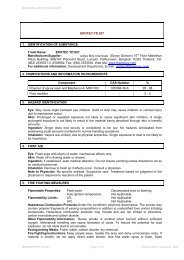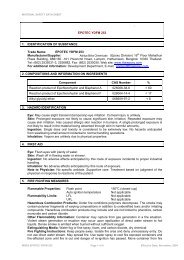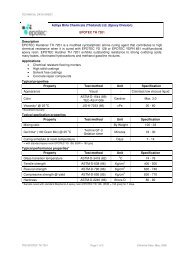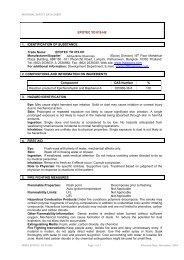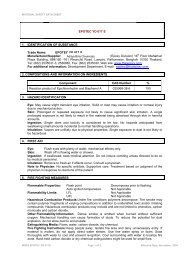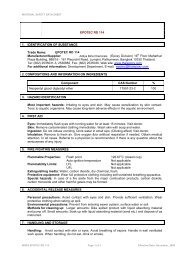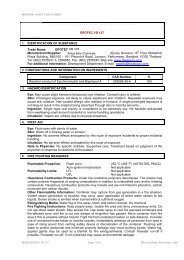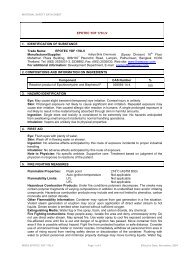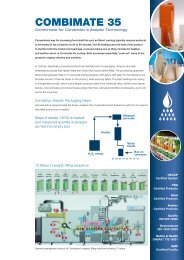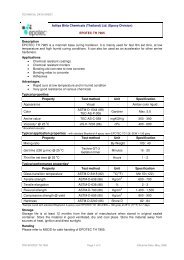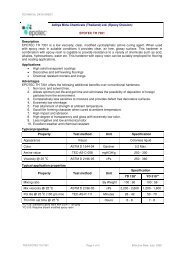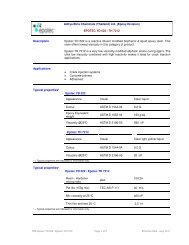EPOTEC YDF 170 L - Aditya Birla Chemicals
EPOTEC YDF 170 L - Aditya Birla Chemicals
EPOTEC YDF 170 L - Aditya Birla Chemicals
You also want an ePaper? Increase the reach of your titles
YUMPU automatically turns print PDFs into web optimized ePapers that Google loves.
MATERIAL SAFETY DATA SHEET<br />
water to protect personnel and minimize property damage may move burning liquids. Water fog,<br />
applied gently may be used as a blanket for fire extinguishments. Contain firewater run-off if<br />
possible. Firewater run-off, if not contained may cause environmental damage.<br />
Protective Equipments for Fire Fighting: Wear positive pressure self-contained breathing<br />
apparatus (SCBA) and full protective equipment.<br />
6. ACCIDENTAL RELEASE MEASURES<br />
Protect People: Isolate area. Clear non-emergency personnel from area.<br />
Protect the Environment: Keep out of irrigation ditches, sewers and water supplies.<br />
Cleanup: Absorb with material such as sand or polypropylene or polyethylene fiber products.<br />
Collect in suitable and properly labeled containers. Remove residual using hot soapy water.<br />
Residual resin can be removed with solvent. Solvents are not recommended for cleanup unless<br />
the recommended exposure guidelines and safe handling practices for the specific solvent are<br />
followed. Consult appropriate solvent MSDS for handling information.<br />
7. HANDLING AND STORAGE<br />
Handling: Avoid use of electric band heaters. Failures of electric band heaters have been<br />
reported to cause drums of liquid epoxy resin to explode and catch fire. Application of a direct<br />
flame to a container of liquid epoxy resin can also cause explosion and/or fire.<br />
Storage: Good general ventilation should be sufficient for most conditions. Local exhaust<br />
ventilation may be necessary for some operations.<br />
8. EXPOSURE CONTROLS AND PERSONAL PROTECTION<br />
Exposure Guideline(s): None established.<br />
Engineering Controls: Good general ventilation should be sufficient for most conditions.<br />
Eye Protection: Use safety glasses.<br />
Skin Protection: Use protective clothing impervious to this material. Selection of specific items<br />
such as face shields, gloves, boots, apron, or full-body suit will depend on operation. Remove<br />
contaminated clothing immediately, wash skin with soap and water, and launder clothing before<br />
reuse.<br />
Respiratory Protection: No respiratory protection should be needed. If respiratory irritation is<br />
experienced, use an approved air-purifying respirator.<br />
9. PHYSICAL AND CHEMICAL PROPERTIES<br />
Appearance:<br />
Light yellowish liquid<br />
Odor:<br />
Mild epoxy<br />
Boiling Point:<br />
Decomposes prior to boiling<br />
Vapor Pressure: Not applicable<br />
Vapor Density:<br />
Not applicable<br />
Solubility in Water: None<br />
Specific Gravity: 1.16-1.22<br />
10. STABILITY AND REACTIVITY<br />
Stability: Stable at ambient temperature.<br />
Conditions to Avoid: Excess heating over long periods of time degrades the resin.<br />
Material to Avoid: Acids, bases, amines and oxidizing agents.<br />
Hazardous Decomposition Products: Refer to section 5 for Hazardous Combustion Products.<br />
Hazardous Polymerization: Will not occur by itself. Polymerization can be catalyzed by aliphatic<br />
amines. Masses of more than one pound (0.5 kg) of product plus an aliphatic amine will cause<br />
irreversible polymerization with considerable heat build up.<br />
MSDS <strong>EPOTEC</strong> <strong>YDF</strong> <strong>170</strong>LV Page 2 of 4 Effective Date: November, 2004



